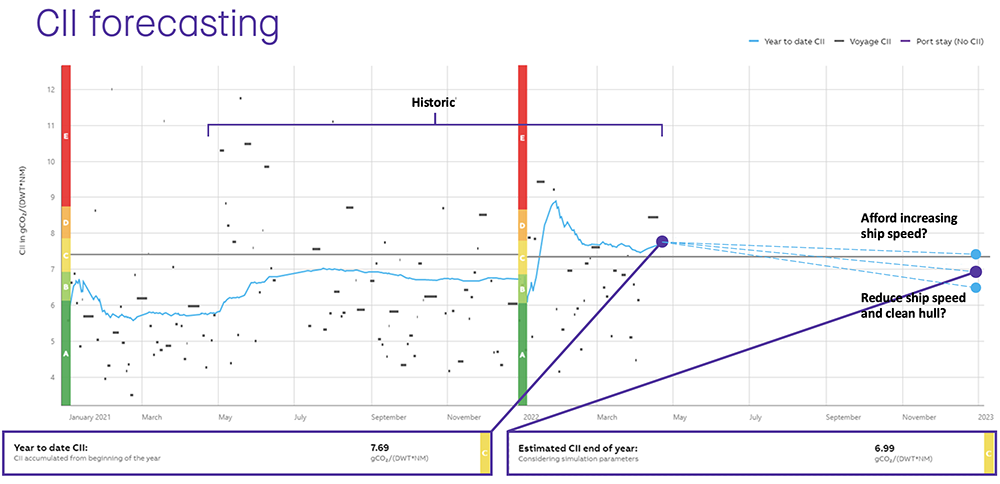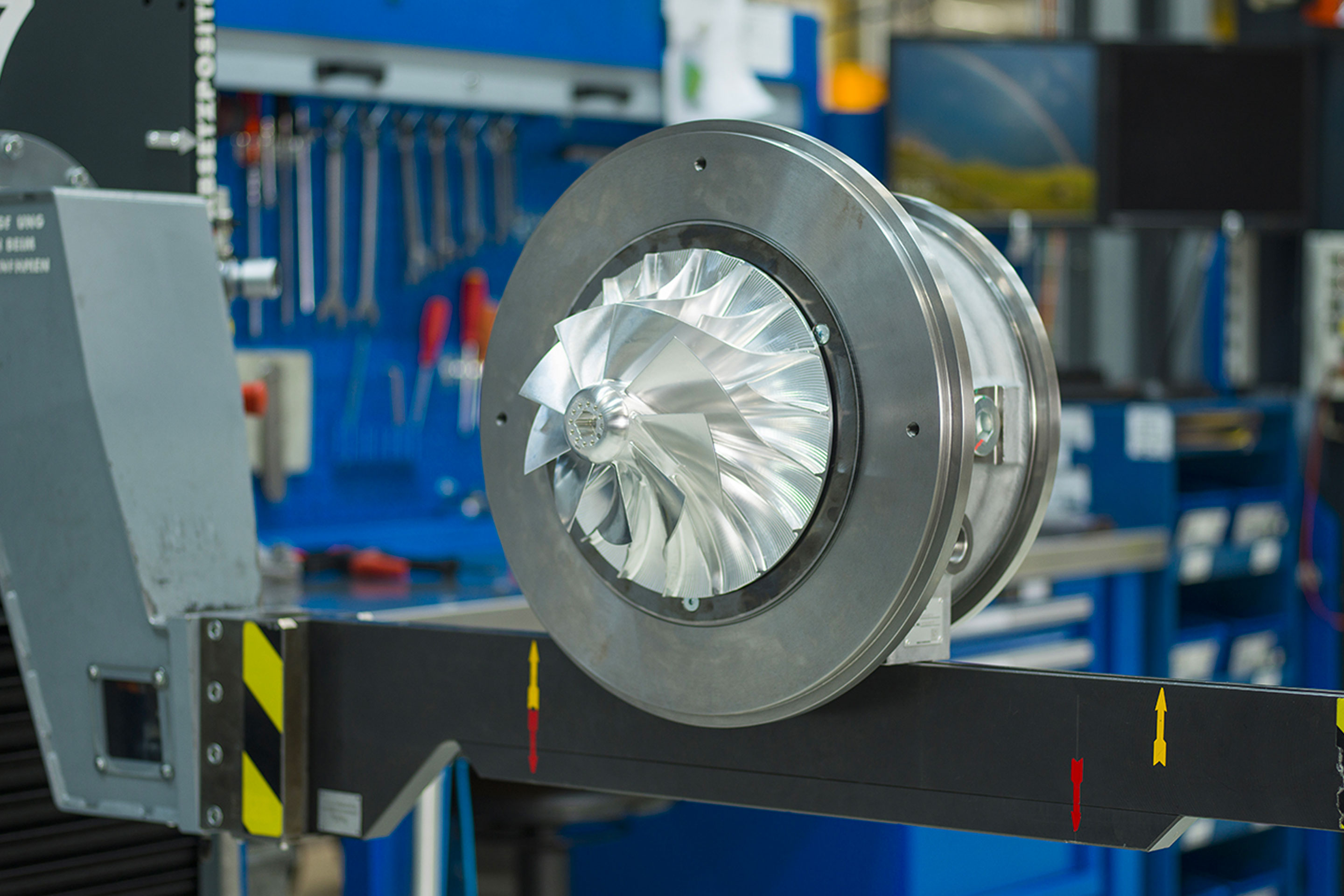Accelleron is a proud sponsor of the Motorship Propulsion & Future Fuels Conference, which kicked off on Tuesday 22nd in Hamburg, Germany, to power shipping’s emissions-cutting ambitions. Accelleron’s own Pascal Reolon, Head of Digital Product Management, presented at the event, highlighting the significance of data in achieving sustainable performance.
Pascal presented the results of a white paper at the Motorship Propulsion & Future Fuels Conference, describing how Accelleron created an interactive display and forecasting tool for ships’ CII (Carbon Intensity Indicator) rating during specific reporting periods.
Delivering an analytic layer on top of mandatory emission reporting, the display and forecasting tool enables ship owners and operators to constantly assess energy efficiency information and to act early on deviations from set targets.
Introduction and context
Over previous decades, fuel efficiency was mainly the concern of those who paid the fuel bill, Pascal explains. Although advanced ship owners always had an eye on the technical specification and condition of their fleet, keeping the engine performance at its maximum level was typically only an objective of companies with strong technical departments.
Engines are now built to increasingly stringent regulations and conditions, however, and investment is required from owners for substantial modifications to engines and turbochargers (potentially subject to recertification) to adjust engine performance to new operation patterns such as permanent slow steaming.
From a practical point of view, fuel oil consumption is impacted by many factors. Draft, weather, hull condition and more make it challenging to assess vessel fuel efficiency. This results in performance baselines in commercial charter contracts which aim to incorporate the most unfavourable conditions. This approach allowed ship owners and charterers to run their business without extensive data acquisition and analytical solutions.
Times are changing, and Pascal points out that the industry has turned to a more data driven mode following the introduction of ISO19030. The concept of high-frequency data acquisition, over a longer period, makes it possible to statistically eliminate outliers (due to external factors) in the speed consumption diagram and to derive typical service relations by using linear or polynomial approximation. The results deliver insights into whether a vessel’s hull and propeller performance has decreased over a period, compared to a previous period just after dry docking.
« The new metrics become relevant for all involved parties because a vessel’s operational energy efficiency is globally benchmarked»
Pascal Reolon, Head of Digital Product Management, Accelleron
Why this is important
Because of the latest CII regulations, hull and propeller performance monitoring is coming under increased scrutiny. The new metrics become relevant for all involved parties because a vessel’s operational energy efficiency is globally benchmarked, says Pascal, and Accelleron has identified several challenges.
For ship owners and managers looking to charter out vessels, these include:
- How are vessels operated related to CII?
- Which CII rating will result at the end of the year (with continued, unchanged operation).
- Can the ship operation be changed to remain within the CII boundaries (rating C), and what impact will this have?
- How to avoid a vessel’s CII rating being reported at a level where amended appropriate measures need to be filed in the SEEMP III.
- Under pressure from consumers, vessels with sub-standard energy efficiency rating may have difficulties finding new charter contract.
- Poseidon principles may move the financing and insurance sector to change the conditions for financing/insuring vessels not meeting requirements.
For ship operators and charterers, challenges include:
- How will the owner’s concern about CII of owned vessels impact ship operation?
- What is the basis for discussion around operational measures related to CII?
We can expect both owners and operators to seek closer cooperation to agree on appropriate measures during reporting periods, and we are convinced CO2 emission management will become an additional driver for remote diagnostics.
How Accelleron can help
Accelleron has an unrivalled record of accomplishment when it comes to turbocharger design, manufacturing, and servicing. This expertise on performance of high, medium and low speed engine components is inherent in our organization. With the acquisition of Tekomar, Accelleron broadened its competencies towards engine performance and the related management of operational engine performance data.
The recent shift in the relevance of the fuel efficiency topic in the shipping industry, combined with Accelleron’s capabilities to ingest, store and process timeseries data efficiently (existing architectural building blocks of our engine and turbocharger remote diagnostics solutions), is our motivation for raising these discussions around emissions forecasting functionality.
We want to provide an analytic solution which addresses the above needs of the shipping industry. The objective is an interactive display of a ship’s CII profile, for each voyage and year to date, and the forecasting of end-of-period CII ratings based on historic data and simulation parameters.
 CII forecasting
CII forecasting
The challenges of CII forecasting
There are plenty of challenges when it comes to creating accurate CII forecasts, and to make Accelleron’s calculations more precise, we analyzed different factors including log speed, cargo and port stay duration on the operational side, hull and propeller performance, and engine performance on the technical side.
All these parameters can be set by the user when simulating the year-end forecast. For operational parameters, Accelleron provides default average values from historic data where available, although deriving historic values for the technical parameters from the underlying emission reporting dataset is not possible.
For a complete simulation of the year end CII, all technical and operational factors are added to the forecast in the same way. Log speed is the most important driver for CII, although it can prove challenging from an operational point of view. If there are upcoming changes in contracts which imply different operational patterns, however, the simulation helps to determine the appropriate conditions. As a final example of Accelleron’s engineered approach to deliver more accurate calculations, we also simulate the addition of log speed increases.
What this all means for ship owners and operators
Having an automated system which displays current and forecasted CII is expected to be one of the must-have tools for ship owners in the future, helping them to harness compulsory emission reporting data and adding an analytic layer that provides the insights to act early on CII ratings.
The simulation of different scenarios can serve as a basis for both short term operational changes as well as long term investment planning related to technical measures. The increased transparency with permanent assessment of ship energy efficiency boosts awareness for sustainability. And in a world with an increasing number of regulatory measures being introduced, these informed decisions are key to leading the way to decarbonization.
Pascal’s white paper also looks at additional aspects of CII forecasting, including data requirements, voyage detection and voyage versus period CII. For more details and to read Pascal’s white paper in full, click here.
Pascal wasn’t the only Accelleron expert to talk at the Motorship Propulsion & Future Fuels Conference, with Simone Bernasconi, Head of Product Line Upgrades, also presenting at the event. Stay tuned, as we’ll be bringing you more on Bernasconi’s presentation soon.














